Book Review: God Gave Rock and Roll to You by Leah Payne
Disclaimer: I received a copy of this book through a Goodreads giveaway for the purpose of writing this review. No other compensation was offered or received.
For a generation, the dominant form of religious music in the North American market was “Contemporary Christian Music.” It was sold in Christian bookstores, sung in Christian churches (or at least at their youth groups) and played on Christian radio. This history looks at the subgenre’s roots, rise to prominence and eventually ebbing as “worship music” took over.

In the late Nineteenth century ,revival meetings needed music to sing, and the new music recording industry needed songs to sell their reels and discs. Both the “Christian” music and country music industries started concentrating around Nashville, Tennesee. (There was, and is, a considerable overlap.) They drew heavily from black Gospel music and blues, though usually through white covers.
Starting in the 1950s, there was an increasing worry among what would become known as the white evangelical community about the youth being corrupted by the “jungle rhythms” (read “Black people’s music”) of rock music. Even as the rock and roll genre became heavily dominated by white musicians, the anti-establishment, open love, anti-segregation, pro-party ethos of then-mainstream rock freaked out the buttoned-down squares in charge of churches.
But you didn’t have to be square to be a Christian. A fraction of those turning on and dropping out found Jesus was transcendent and able to be found even when you weren’t necessarily looking. These “Jesus Freaks” started making “Jesus music” that drew on rock and its musical trends of the time.
Reluctantly at first, the Christian music industry started working with Jesus music–it was, after all, a moral substitute for the devil’s rock and roll. Especially helpful for keeping the youth entertained and not going somewhere other than the church basement.
Over the course of time, being the “moral substitute” for the music popular with the rest of the culture became CCM’s big thing. It helped that conservative white evangelicalism had become its own subculture, with Christian bookstore chains, Christian radio stations, Christian TV channels and a Moral Majority mindset all feeding into each other. It became a multimillion-dollar business.
But the insular nature of the subgenre came with problems. The industry and the fandom wanted performers who were the moral paragons that embodied the values proclaimed in their songs. A failure to live up to that, especially when it came to the right kind of sex, crashed several careers. Nonwhite artists were excluded unless they conformed to white cultural standards. And a growing adherence to right-wing politics tainted the message for many.
Plus, CCM artists that were able to “cross over” to popularity on the regular charts were viewed with suspicion at best, and often had to abandon one market or the other. Contemporary Christian Music was often derided for low quality.
The devotion to the “Becky” market eventually made the CCM industry vulnerable to changes in the market. The internet allowed Christian musicians to reach listeners without the strict gatekeepers, the evangelical left came out of its shell, and American tastes changed to a wider variety of styles, skin complexions and national origins for religious music. “Worship music” became the next big thing.
And of course, conservative white evangelicalism’s adherence to the less savory parts of Republican policy led them to support a certain candidate for president, and his insurrection, turning off more segments of the potential audience.
This book seems well-researched, though the author notes many people she talked to would not go on the record. No illustrations, but copious footnotes with citations, and an index.
Having been adjacent to the target audience of CCM over the years (I’ve owned some of the albums mentioned) I found this an interesting subject and a fun read. Some readers may be turned off by the frank discussion of racism within the music industry and other political entanglements, but those are subjects that are integral to a fair retelling of events.
I’d recommend this book to music fans, people curious about the Contemporary Christian Music subgenre, and American church history buffs.

